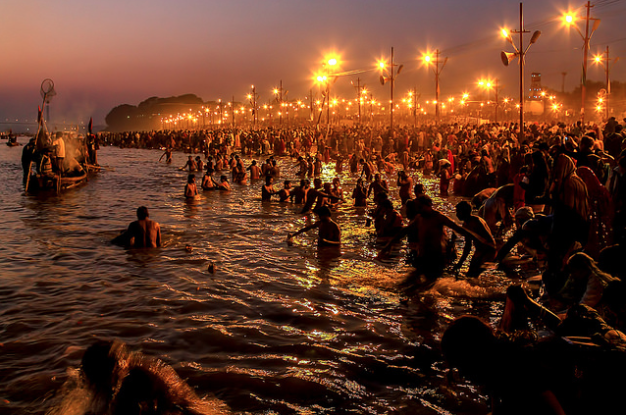
The Kumbh Mela is the largest spiritual gathering in the world. Millions of seekers and Hindus congregate together to pursue moksha (liberation) from the wheel of samsara (the repeating cycle of birth, life and death). Hindus gather from all over India and around the world to participate and celebrate in this massive pilgrimage of faith by bathing in the sacred rivers to be cleansed of all sins and karma from many lifetimes.
The Kumbh (which means pot), mela (fair or gathering) is held in four locations every 12 years for the main festival, six years and three years in accordance to the zodiac positions of Jupiter (Guru), Sun (Surya) and the Moon (Chandra). The location of this great festival takes place in a rotation of the following locations: Haridwar, Allahabad (Prayag), Nashik/Trimbakeshwar, and Ujjain. All of these locations are on the banks of holy, sacred rivers: the Sangam (confluence of three rivers); Ganges (Ganga), Yamuna in Haridwar, Sarasvati in Allahabad, Godarvi in Nashik, and Shipra in Ujjain. Every 144 years a Maha (Great) Kumbh Mela occurs; one in Haridwar and Allahabad, and an Adhra (Half) Kumbh Mela is held every sixth year.
This particular period for the upcoming Kumbh Mela is unique and highly auspicious as it only occurs once every 300 years in Nashik and Ujjain while Jupiter (Guru) is in Leo and in his peak energy. This time is called Simhastha. Jupiter unites with the Sun (Surya) and moves in high speed while all the other Grahas (planets) are subdued under Jupiter’s influence.
What happens exactly is all the planets support spiritual knowledge, initiations and enlightenment. In this particular time and window, all beings who participate in the Kumbh Mela and who take a dip in the holy river, have the possibility of obtaining higher states of consciousness and liberation from all their karma. It it the best time to work in the line of enlightenment.
The significance of the Kumbh Mela dates back to the ancient, prehistoric texts of the Puranas. According to Hindu mythology, the history of the Kumbh Mela has various versions, but they all revolve around the Samudra Manhan, also known as the The Churning of the Milky Ocean. This story appears in the Bhagavata Purana, the Mahabharata and the Vishnu Purana. This epic tale has many profound implications for the spiritual seeker who wants to obtain liberation from the pain and suffering of life and death.
In one version of the story, the Devas (Gods) and asuras (demons) had only one desire and that was immortality. Lord Vishnu (the God who preserves the universe) told the Devas and asuras that the only guarantee to obtain immortality was to churn the Milky Ocean for the amrita (immortal Divine nectar). The Devas and asuras obliged and formed two teams on each side with a long rope (which is Lord Shiva’s Serpent King Snake Vasuki) wrapped around a large rod (Mount Mandara) in the middle of the ocean. The whole set up was placed on Lord Vishnu’s Kurma Avatar (a tortoise). The Churning of the Milky Ocean proceeded with great determination from the Devas and asuras.
As they churned, much to their dismay, a horrendous poison was flooding out from the depths of the ocean which was encompassing the whole universe. The Devas and asuras not knowing what to do approached Lord Shiva (the God of destruction and transformation) to find a solution for the calamity which was taking place. Lord Shiva immediately took the poison into his throat and swallowed it, turning his throat blue. He was thereafter called called Neelkanth, meaning; The Blue Throated One.
It was at that moment the amrita emerged from the ocean amongst many other treasures. A Deva named Jayanta took the pot (kumbh) of amrita and flew towards the heavenly planes. When the asuras (demons) found out the Devas took to pot of amrita they became angry and chased them with the intent of retrieving the jug. This chase lasted 12 days in Deva time, which is 12 years for humans, thus the significance of the Kumbh Mela being held every 12 years. During those 12 years, it is believed that, during the fighting, the nectar spilled out of the pot and into these four locations of Haridwar, Allahabad (Prayag), Nashik/Trimbakeshwar, and Ujjain.
Saints, sages, sadhus and intense seekers flock to the Kumbh Mela for the sake of spiritual purification, liberation and enlightenment. It is the most peaceful and non-violent gathering where millions amass for the ultimate upliftment of humanity.
~
Author: Sarvasmarana Ma Nithya
Editor: Travis May
Image: Flickr/AlGraChe & Wikipedia










Read 12 comments and reply